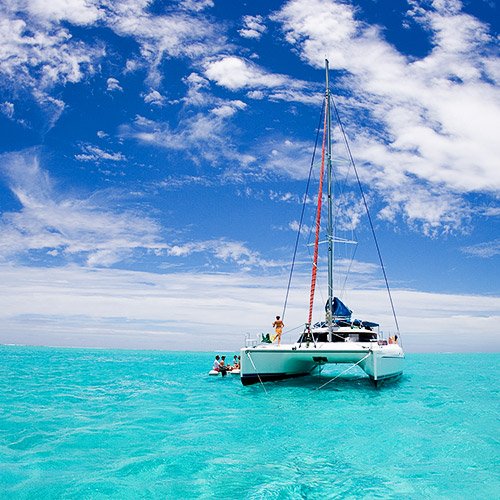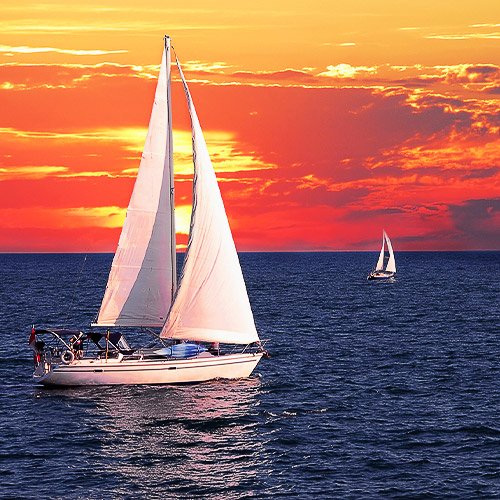The majority of people take up sailing as a hobby because of its relaxing moments and therapeutic benefits. The calming sound of the waves and the boat's soft swaying can be quite comforting. But the more time you spend on a boat, the more you want to live there forever, surrounded by loved ones and the wide, open sea.
For those with a hunger for racing, sailing offers plenty of thrilling events that can satisfy your desire for adventure and competitiveness. These competitions are about more than just winning; they're about testing your sailing prowess, growing as a team, and experiencing the friendship that results from sharing a common interest. Moreover, these sailing events provide fantastic opportunities to see breathtaking scenery and engage with many cultures, making all of them an amazing experience.
In this article we’ll talk about some of the most popular boating competitions around the world that any sailor, professional or amateur, will want to take part in! Whether you want to see one of the oldest international races in the world or you want to experience the beauty of the spectacular regattas in Italy, there is a race for everyone. Come along as we explore these must-see sailing events and learn what makes them so unique!

America's Cup World Series
capetanos.com1. America's Cup World Series
Founded in 1851, the America's Cup is one of the oldest, if not the oldest, international sailing competition. Two yachts compete in the match races: the defender, which is the club that currently owns the trophy, and the challenger, which represents the club that is fighting for the cup. Events take place on dates decided upon by the two clubs, sometimes a few years apart. Although there isn't a set schedule, the races usually take place every three or four years. The next America's Cup will take place in Barcelona, Spain on October 12, 2024, between the current champion, Royal New Zealand Yacht Squadron and another impressive yacht club.
The Deed of Gift of the America's Cup regulates all America's Cup challenges, specifying who is eligible to compete and what details must be given to the defense. The deed then allows for most of the arrangements for the match to be made by negotiation and mutual consent, but provides a backstop if an agreement is not reached.
Due to its esteemed status, this tournament draws the best professional sailors, yacht designers, and the wealthiest sponsors and businesspeople. The design of the boat is as important to the race as sailing abilities. For additional details on how to go to the next match, go to the official website at https://www.americascup.com/.

The Ocean Race
capetanos.com2. The Ocean Race
The Ocean Race is a yacht race around the world, held every three or four years since 1973. Starting in Europe in October, this competition is known as the longest and the most challenging professional event worldwide as its duration is almost nine months.
The next edition is scheduled to start in Germany in 2025. The Ocean Race Europe will prioritize educational programs for race fans and schoolchildren as well as the competition. From the Baltic Sea in the north to the Mediterranean Sea in the south, the oceans are changing, and an onboard research program will collect important data from the race boats to give experts to analyze. This competition will also highlight environmental sustainability, inspiring both participants and spectators to raise awareness of ocean conservation initiatives. For more information visit https://www.theoceanrace.com/en/home.

Rolex Sydney to Hobart Yacht Race
capetanos.com3. Rolex Sydney to Hobart Yacht Race
The Cruising Yacht Club of Australia hosts the annual Rolex Sydney Hobart Yacht Race, which begins on Boxing Day in Sydney, New South Wales, and ends in Hobart, Tasmania. The race course, which is roughly 630 nautical miles, makes it one of the most challenging sailboat competitions in the world.
Australia’s foremost offshore sailing prize is The George Adams Tattersall Cup. This award is given to the overall winner of the race in which the yachts are judged according to their dimensions—length, width, weight, and sail area. Still, the majority of viewers focus on the "line honors," a prize awarded to the first boat that crosses the finish line.
On December 26, 2024, the 79th edition of this competition will get underway on Sydney Harbor. Some changes from the previous races will be put in place, the most significant being that in order to encourage the participation of more women and young people, a boat's IRC crew number can be increased by one if it has two female crew members, two youth (under 23) crew members, or one youth and one female member during the race. Entries for the 2024 event can be submitted now on the official website, https://rolexsydneyhobart.com/ , and will close on October 25.

The Barcolana
capetanos.com4. The Barcolana
One of the biggest and most well-known regattas held in the Italian Gulf of Trieste each year is the Barcolana. With 2,689 boats and more than 16,000 sailors on the starting line, this race was named "the greatest sailing race" in January 2019, setting a new Guiness World Record.
The Barcolana is a unique event on the international sailing scene because of its special formula: beginner and expert sailors, as young as eight years old, compete side by side on boats of various sizes that are divided into various categories based on overall length. To learn more about upcoming races, check out https://www.barcolana.it/en.

Vendée Globe
capetanos.com5. Vendée Globe
The Vendée Globe is a solo non-stop round the world race that takes place every 4 years. It is named after the Département of Vendée, in France, where the race starts and ends. The Vendée Globe is regarded as the ultimate challenge in ocean racing and an intense test of a person's strength. The harsh and unpredictable weather that sailors have to deal with, along with the emotional impact of spending months alone at sea, contribute to make the Vendée Globe an even more difficult task. Therefore, in the sailing world, finishing the race is a noteworthy accomplishment.
Before competing, contestants must complete medical and survival courses in an effort to lower the risks. They also need to be able to prove that they have past racing experience—either by having finished a Vendée Globe or a single-handed transoceanic race. In order to compete in the race, a sailor must either finish a second transoceanic observation passage or the qualifying race on the same boat they will race in. For details regarding the race this year and the skippers that are participating, go to https://www.vendeeglobe.org.

Rolex Fastnet Race
capetanos.com6. Rolex Fastnet Race
Along with the Sydney to Hobart Yacht Race and the Newport-Bermuda Race, the Fastnet Race is considered one of the classic events, testing inshore and offshore skills, boat and crew preparation, and speed potential. This event, which was first held in 1925, has always been linked to advancements in sailing technique, safety gear, and yacht design. The regatta is held by one of the UK’s oldest yacht clubs, the Royal Ocean Racing Club.
This is a difficult competition. The race, which takes place in August, frequently experiences strong to gale-force west winds. The series of low-pressure systems that move over the North Atlantic Ocean into Britain and Ireland provide a continually shifting weather pattern that navigators must account for. The key to winning the race is understanding where weather disruptions are most likely to occur and how to take advantage of them. The official Fastnet Race website, https://www.rolexfastnetrace.com/en/, will discuss the start date of the next race in 2025 and update the calendar.

Essential Tips and Strategies
capetanos.comPreparing for a race: Essential Tips and Strategies
It's not easy to race as an amateur sailor. Many factors, including physical and mental preparation, quality tools, and flawless execution, are necessary for success. That's why having an effective pre-race routine will help you out in many areas of the race. Even before you get out on the water, you should utilize a targeted strategy to establish a pattern and focus without wearing yourself out. Though there are many more things you may do to start the race ahead of the competition, here are some pointers that you should keep in mind.
On Land
- Building a crew: Finding people to help you on your journey can be quite easy. Make sure you have covered the important roles, though. Find additional crew members to contact besides the ones mentioned in case someone is unable to make it. Try using a service like Google Forms to gather necessary information, such availability or equipment requirements, organized and in one spot for improved efficiency.
- Checking the weather: A few days ahead of schedule, ask your navigator to let the crew know what the expected weather is. To keep everyone in the loop, it's crucial to provide useful information on the courses, start time, and the exact moment you want to get in the water. Your sail choices for the day will also be determined by the course information and weather forecast.
- Rig setup: You will need to adjust your rig as the conditions change to get the most out of your equipment. See whether there is a tuning guide for your class or boat, and if so, follow it! Practice fine-tuning your boat as your team gains experience, and observe what feels fast. Attempt to get that additional bit of speed; it will add up to a major difference. Reset your equipment to default settings the night after a race so you can start fresh the following day.
- Debrief: Looking back on the last race you completed is usually the greatest approach to be ready for the upcoming one. In certain crews, the conversation might come up naturally. For the others, you might want to create a debriefing outline or post-race checklist to encourage communication and keep the crew on the same page. Furthermore, areas for growth can be identified by documenting and evaluating racing data, such as boat speed, sail trim, and tactical choices. You can keep improving and competing in next races by implementing these strategies.

Building a crew
capetanos.comIn the Racing Area
- Leave time to warm-up: It can save you time to get out early and practice tactics, choose which sails to use, and assist the captain in estimating how long it will take to bring the boat up to maximum speed off the line if you stay in contact with the crew about when to meet and prepare. Being able to sail around prior to the first race will help the tactician determine lifted tacks, where the holes are on the race course, and get the crew coordinated. Arriving early will also allow you to have a small snack and drink some water before the warning signal.
- Observe other boats: If you want to save time, stay in the starting area and watch other boats sail the beat rather than sailing it yourself. This is because, in the lead-up to the race, boats are sailing in different parts of the course, so by watching other vessels, you can gather more information than if you were to sail one path (or two up the leg) alone. You can gather information from multiple boats about shifts, lifted tack, and wind velocity for at least 20 minutes.
- Check the boat speed: For the best speed under different conditions, take your time optimizing your sail controls. Line up and check speed with a partner, if available, so you can compare performance and make any necessary adjustments. To maintain speed and efficiency during windy circumstances, concentrate on improving your transitions. Different waves can have a big impact on your boat's speed and handling, so pay close attention to the wave set on each tack. Learn how to navigate each wave set quickly by modifying your sail trim and technique.
- Check the line: This is one factor to consider when choosing where to start. Remember, you are checking the line set against the wind direction, not the mark placement. Get a line sight. Although you might not always be able to use it, it can be extremely helpful. Getting at least two-line sights is advised by many sailors. One should be taken immediately on the line, and the other should be taken from behind the line, where you wish to set up after your final approach. Find out how long it takes to sail up and down the line in case you have to change your plan of action later on in the sequence.
Sailing is a unique activity that blends technical ability, mental strength, physical endurance, and a strong bond with nature. Sailors have the opportunity to push their limits, improve their relationships with their crew, and take in the breathtaking views of the world's oceans and rivers when they compete in prestigious sailing contests. It's an experience unlike any other. Every race has its own mix of rewards and obstacles, from the demanding Vendée Globe to the famous America's Cup.
It takes more than simply passion and a love of the sea to compete in these competitive sailing races, as we've discussed in this article. It takes much preparation, both in and out of the water. A well-prepared sailor must prioritize mental resilience, strategic planning, and physical fitness. Crucial parts of race preparation include knowing the ins and outs of sail controls, maintaining gear, and being adaptable to changing weather conditions.
Think about the advice and tactics covered here when you get ready for your next race. Every detail matters, from establishing a methodical pre-race routine to perfecting your boat and reviewing race statistics. You can improve your chances of success and enhance your performance by continuously learning and adapting. Set your sails, seize the opportunities, and ride the waves with enthusiasm and confidence. Your next adventure awaits!

Competitive sailing
capetanos.comFrequently Asked Questions (FAQ)
1. How important is physical fitness for competitive sailing?
Physical fitness is crucial for handling the physical demands of sailing, including maneuvering the boat and maintaining endurance during long races.
2. What should I focus on during pre-race preparations?
Pre-race preparations should include optimizing sail settings, practicing smooth transitions, and studying weather patterns and wave conditions.
3. Why is post-race analysis important, and how can I conduct it effectively?
Post-race analysis helps identify areas for improvement. Conduct a structured debrief, review race data, and seek feedback from experienced sailors or coaches.




